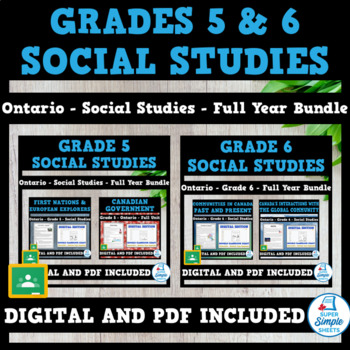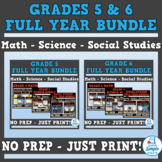UPDATED Ontario - Grade 5 & 6 Social Studies - FULL YEAR BUNDLE
- Zip
- Google Apps™

What educators are saying
Products in this Bundle (4)
Also included in
- FULL YEAR BUNDLE - Split Grade Teaching made easy! This NO PREP - JUST PRINT bundle includes everything you need to teach Math, Science and Social Studies. It covers all the expectations in the Grades 5 & 6 Ontario curriculums. Grade 5 - New Ontario Math Curriculum 2020 – This bundle covers allPrice $165.00Original Price $217.90Save $52.90
Description
FULL YEAR SPLIT GRADE BUNDLE - GRADES 5 & 6! NEWLY UPDATED IN 2022! BOTH DIGITAL AND PDF VERSIONS NOW INCLUDED
Students will practice literacy skills when demonstrating their understanding of the subject material. These sheets were made for cross-curricular connections between language and social studies. Students will make connections, infer, support their answers with evidence from the text, and summarize. Each worksheet contains a reading followed by questions for them to demonstrate their learning. Students will enjoy the matching, true or false, and multiple choice questions.
Ontario Social Studies Grade 5 Curriculum
Strand A: First Nations and Europeans in New France and Early Canada
Some of the concepts that are covered:
- Understanding of the term Indigenous (First Nation, Métis, and Inuit)
- In depth activities for each Indigenous community (Many First Nations, Métis, and Inuit)
- Daily life and culture of the following First Nations – Algonkin, Wendat, Ojibwe, and Haudenosaunee (Mohawk, Oneidas, Onodagas, Cayugas, and Seneca)
- Haudenosaunee Confederacy – Tree of Peace, Diplomacy, Trading Alliances, Military Alliance, Canada learning Democracy from Haudenosaunee, Grand Council
- French alliances with the Wendat (Huron) and Algonquin
- Role of women in First Nations – Clan Mothers in the Haudenosaunee
- Creation Stories of Indigenous groups (Turtle Island)
- Three Sisters – Corn, Beans, and Squash
- Importance of the Buffalo
- Longhouse and Wigwam Shelters
- Inuit trading as well as trade between First Nations
- Treaties – Wampum Belts
- European Explorers – Cabot, Cartier, De Champlain
- Motivations for explorers
- Fur Trade – couriers de bois, Métis, benefits and negatives of fur trade for Europeans and Indigenous groups
- New France – Missionaries, Jesuits, Citizens in New France (Governor, Intendent), Seigneurs and Habitants
- Smallpox and Scurvy
- How the Europeans learned from the Indigenous
- Comparing childhood as an indigenous child and a New France child
- Loss of land for indigenous groups (treaties, Indian Act)
- New France effects on present-day Quebec
- Benefits and Negatives of contact between Indigenous and European groups
- 2 Unit Tests for this massive unit
- Assignments (many research assignments and a culminating assignment)
Strand B: The Role of Government and Responsible Citizenship
Some of the concepts that are covered:
- What is citizenship?
- Rights and responsibilities of Canadian citizens
- Charter of Rights and Freedoms
- Canada’s Fundamental Elements – Bilingualism, Multiculturalism, Democracy, Inclusivity
- Collective Rights (rights of different groups – Indigenous and Francophones)
- Métis National Council and Métis Nation of Ontario (Self-Government)
- What is Democracy
- Representative Democracy vs Direct Democracy (Comparison to Ancient Greece)
- Why citizens need to participate in Democracy
- How citizens can participate in government (Town Hall Meetings, Band Council Meetings)
- Levels of government (Federal, Provincial/Territorial, Municipal and Shared)
- Responsibilities of each level of government – services they offer
- Shared responsibilities between levels of governments
- Which level of government to call if you have an issue
- Election process
- Appointed and elected positions in our government
- Writing a letter to our municipal government about a social issue (bullying, homelessness, etc.)
- Major political parties in Canada and their platforms
- Taking action against the government – protest movements
- Examples of protests – Black Lives Matter, Women’s March, Climate Change, Coastal GasLink
- Indigenous self-governments (Haudenosaunee, Inuit, and Métis)
- Consulting and Accommodating Indigenous groups in Canada
- Climate change and its affect on Inuit communities
- Evaluating how Canada is doing in correcting climate change
- How governments are working today to correct climate change (Canadian government and Inuit Self-Government)
Ontario Social Studies Grade 6 Curriculum
Strand A: Communities in Canada, Past and Present
Some of the concepts that are covered:
- The Numbered Treaties – Effect on Indigenous Communities
- Treaties in Ontario – Which Treaty Agreement Covers My Community?
- Early life in my community – settlers and indigenous communities
- Indian Act – Effect on Indigenous Communities
- Residential Schools – Readings and research assignment
- National Aboriginal Veterans Monument - National Indigenous Peoples Day
- Indigenous Group of Seven – Fighting for indigenous art and culture
- Haudenosaunee Confederacy – Impact on the Canadian government structure
- Expulsion of the Acadians – conflict between British and French communities
- Immigration to Canada – Push and Pull Factors
- Immigration Act – Discrimination towards certain ethnicities
- Chinese Head Tax
- Japanese Interments
- Anti-Asian Riots in British Columbia
- Life as a French and British Settler
- Land use in New France and British North American
- The Catholic Church – Schools and religion in Early Canada
- Irish Settlers – Culture and building the canals
- Metis and Irish – Bannock and Red River Jig (Fiddling)
- Home Children
- African Canadians – Slavery and the Underground Railroad
- Doukhobours in Canada – discrimination against a religious group
- The Famous Five – Women’s suffrage (right to vote)
- Urbanization – communities in the city versus in rural areas
- Labour unions – communities improving working conditions
- Inuit community – creation of Nunavut
- Inclusion in Canada – our rights and freedoms
- Canada’s national symbols – the beaver and the maple leaf
- Research assignment – early life in your community
- Unit test
- Answer pages for all activities
Strand B: Canada's Interactions with Global Community
Some of the concepts that are covered:
- What is the global community
- Canada’s trading partners
- Imports and exports
- Canada’s top imports and exports
- Free trade and tariffs
- NAFTA – free trade relationship with Mexico and the USA
- Mapping Canada’s trading partners
- Latitude and longitude
- The latitude and longitude of Canada’s trading partners
- Proximity of Canada’s trading partners – Great Lakes region
- Drawbacks of international trade – loss of manufacturing jobs, invasive species (zebra mussels)
- Intergovernmental organizations (IGOs)
- G20, United Nations, International Criminal Court (ICC), International Labour Organization (ILO), WHO
- The WHOs response to the COVID-19 pandemic
- Other epidemics – Zika and Ebola
- Military alliances – pros and cons
- NATO and NORAD alliances
- Peacekeeping operations in Afghanistan
- NGOs – how they operate and who they help
- Ryan’s Well, Doctors Without Borders, World Vision and more
- Earthquake in Haiti Relief – Canadian government response and Canada Red Cross
- Assignments – Researching NGOs and IGOs
- Answer pages for all activities
***Answer Pages for all worksheets are included
Follow Super Simple Sheets for more resources like this one!



